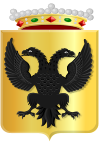Breskens
| Breskens | |||
|---|---|---|---|
|
|||
 Breskens in the municipality Sluis |
|||
| Coordinates: 51°23′42″N 3°33′25″E / 51.39500°N 3.55694°E | |||
| Country | Netherlands | ||
| Province | Zeeland | ||
| Municipality | Sluis | ||
| Population (1 January 2010) | 4,787 | ||
Breskens is a harbour town on the Westerschelde in the municipality of Sluis in the province of Zeeland, in the south-western Netherlands. Its population is 4,787 (as of 2010[update]).
The town is noted for the Visserijfeesten (Fishery Festival), the largest festival in Zeeland.
A ferry connection exists between Breskens and Vlissingen. After the opening of the Western Scheldt Tunnel near Terneuzen in 2003, the ferry now only carries pedestrian and bicycle traffic.
The lighthouse of Breskens is the oldest remaining cast-iron lighthouse in the Netherlands. It was built in 1867 and became a monument in 1982.
In early 1487 Maximilian I, Holy Roman Emperor, granted the coastal region of the Scheldt as a fief to Philip of Cleves. The coastal areas were drained and the village of Breskens was founded in 1510.
On 14 May 1940, with the German army approaching, the Dutch government fled to London. Queen Wilhelmina initially ordered the British captain removing her from the Hague to set sail for Breskens from where she wished to lead the resistance against the invading armies. One of the reasons was that Breskens, having two fortresses in the vicinity, could be well defended. She was advised by the captain that he was under orders not to make contact with the Dutch shore as it was under heavy air attack, so Wilhelmina took the decision reluctantly to go to Britain, planning to return as soon as possible.
On 11 September 1944, during Operation Switchback, the town was carpet-bombed by Allied forces, leaving very little of the historical centre intact. After the war, the town was rebuilt and became a centre for the Dutch fish industry and other maritime-related businesses.
...
Wikipedia


